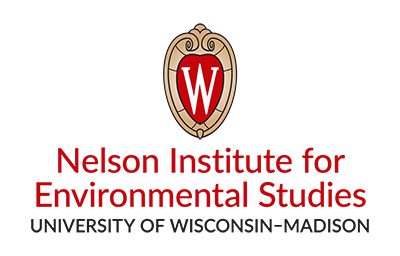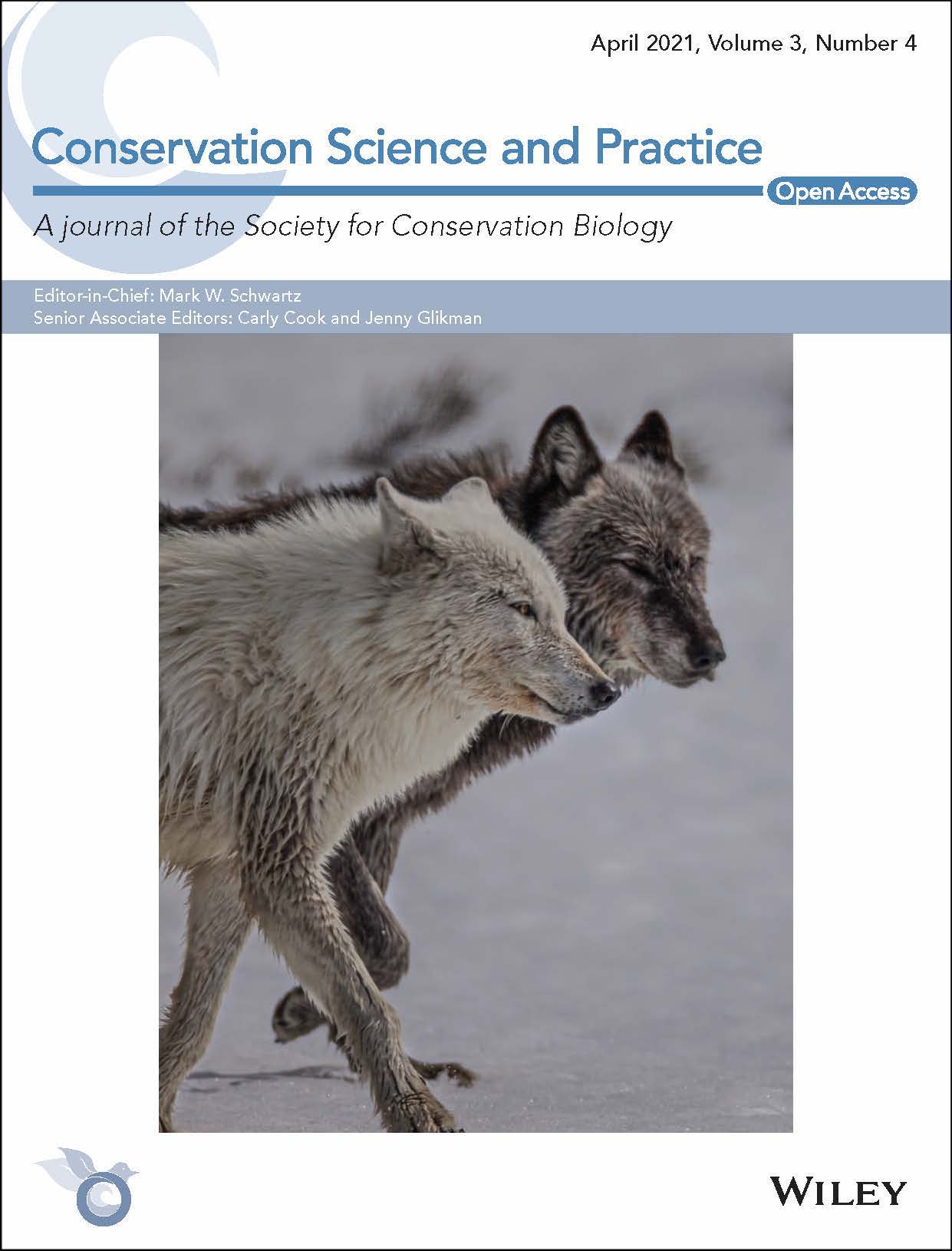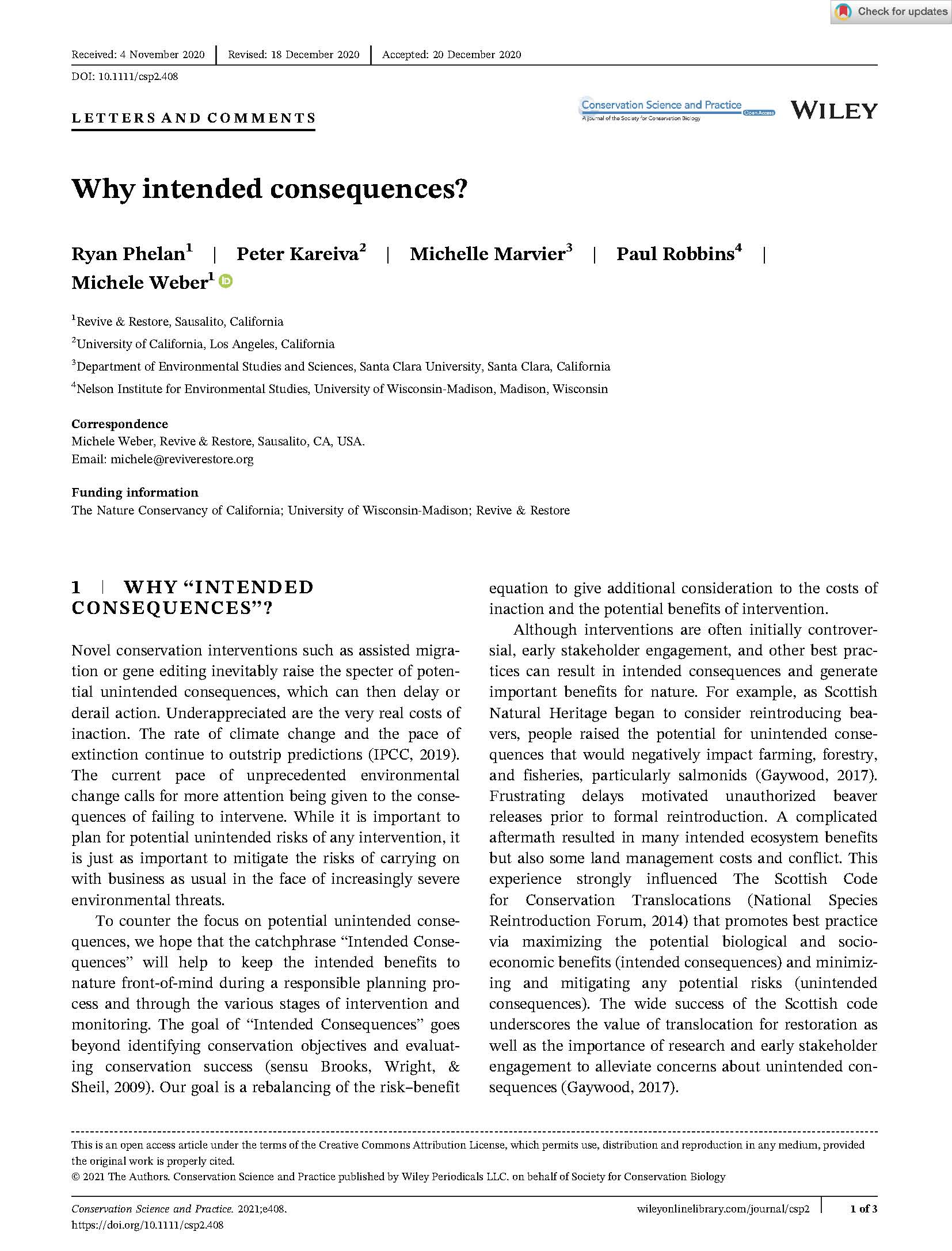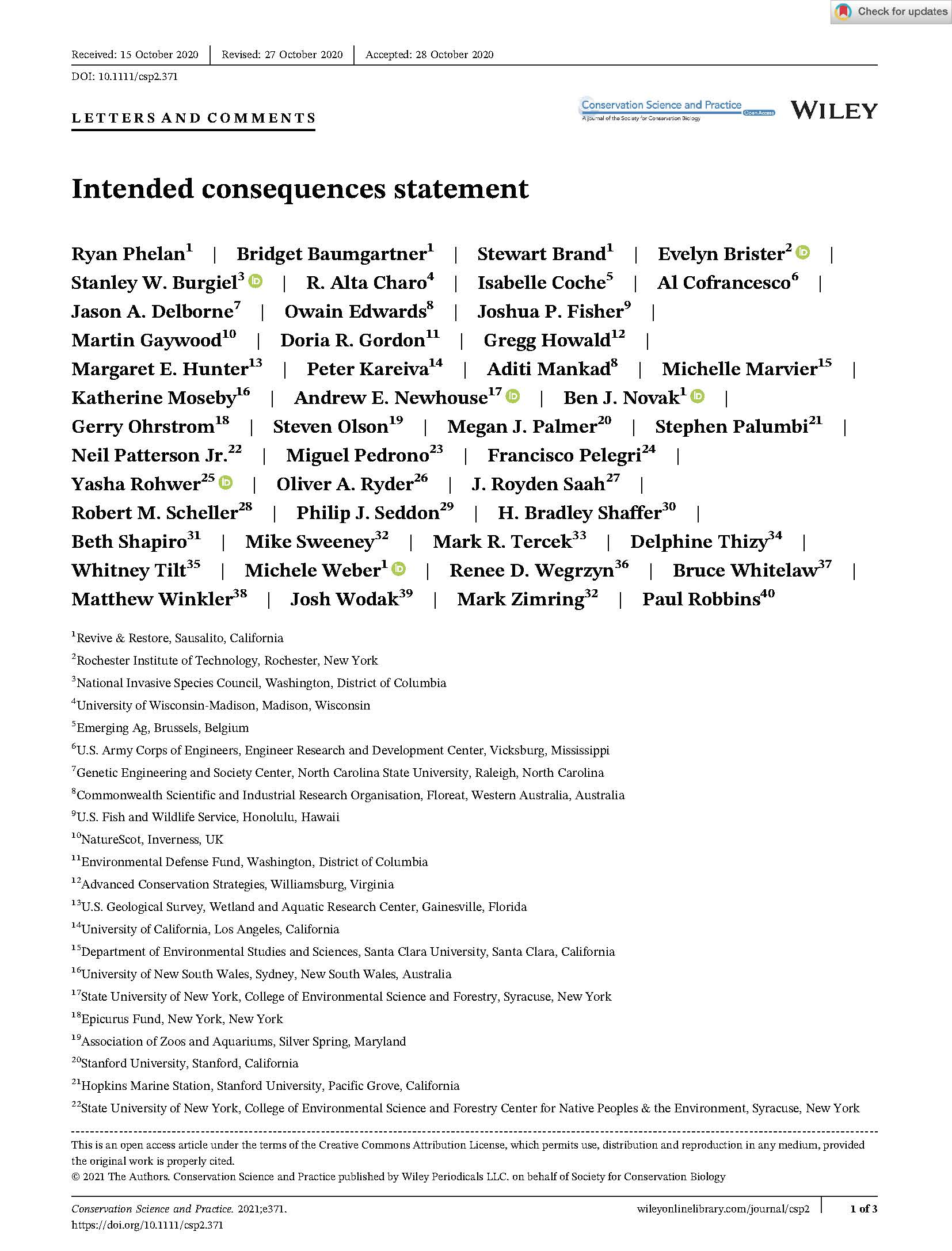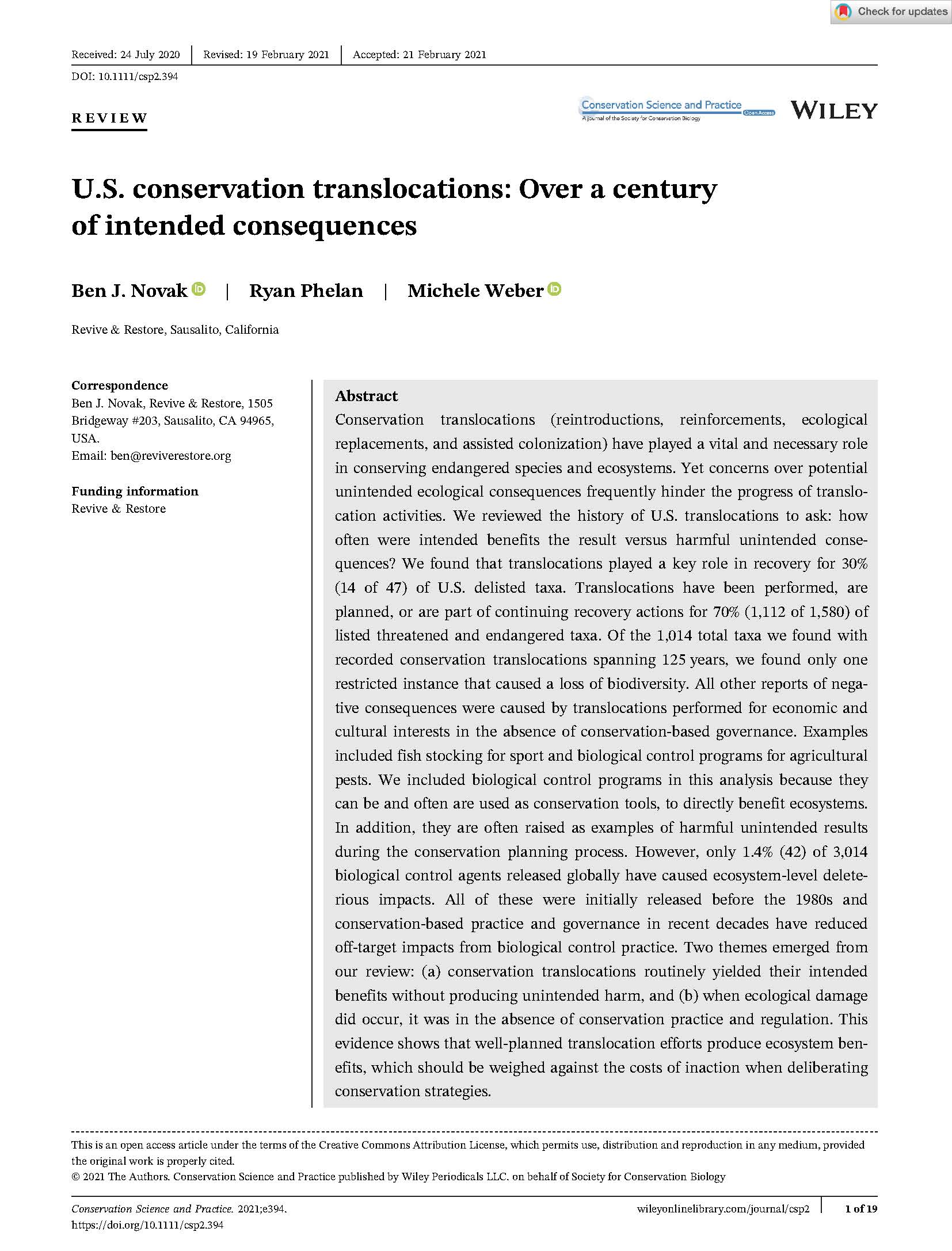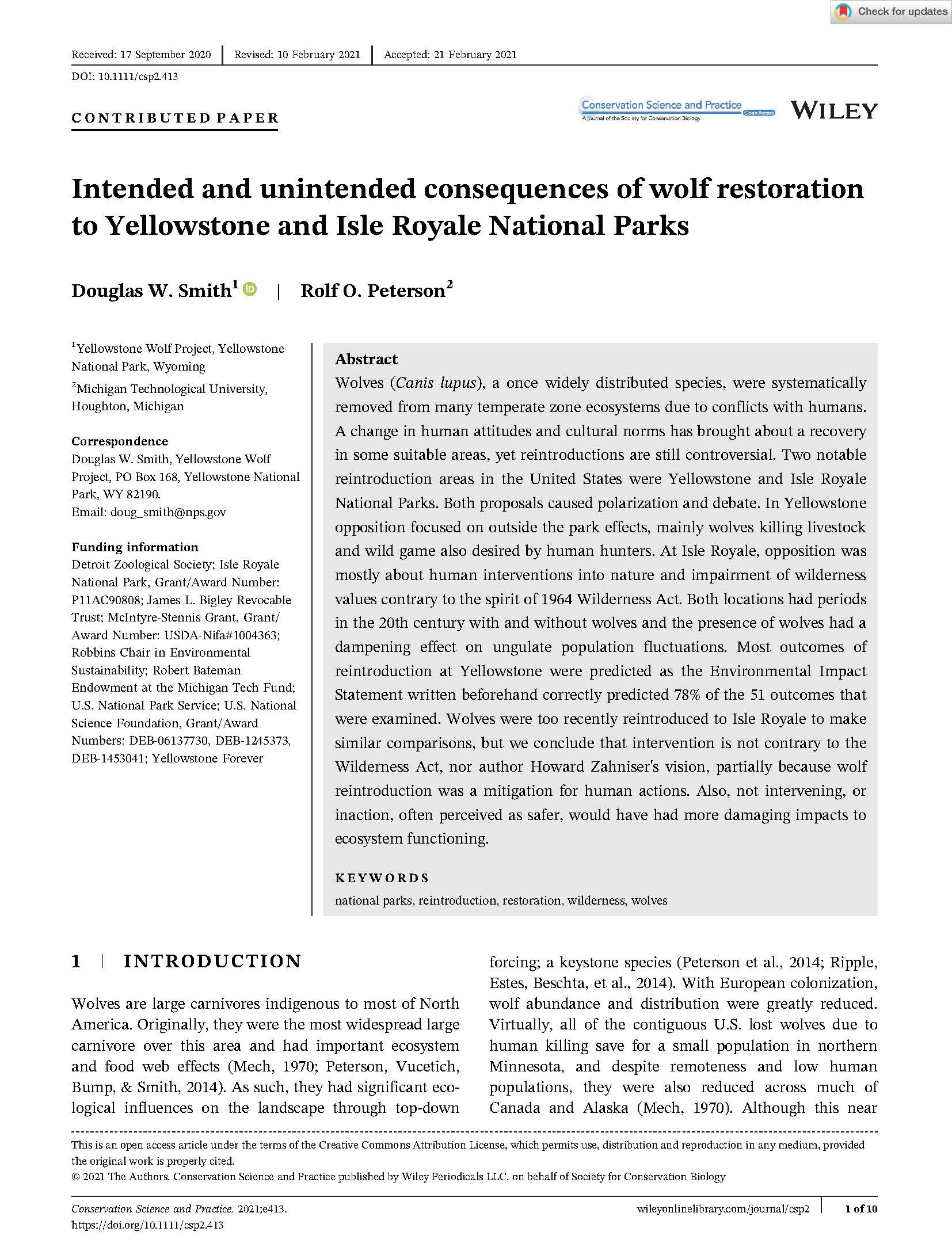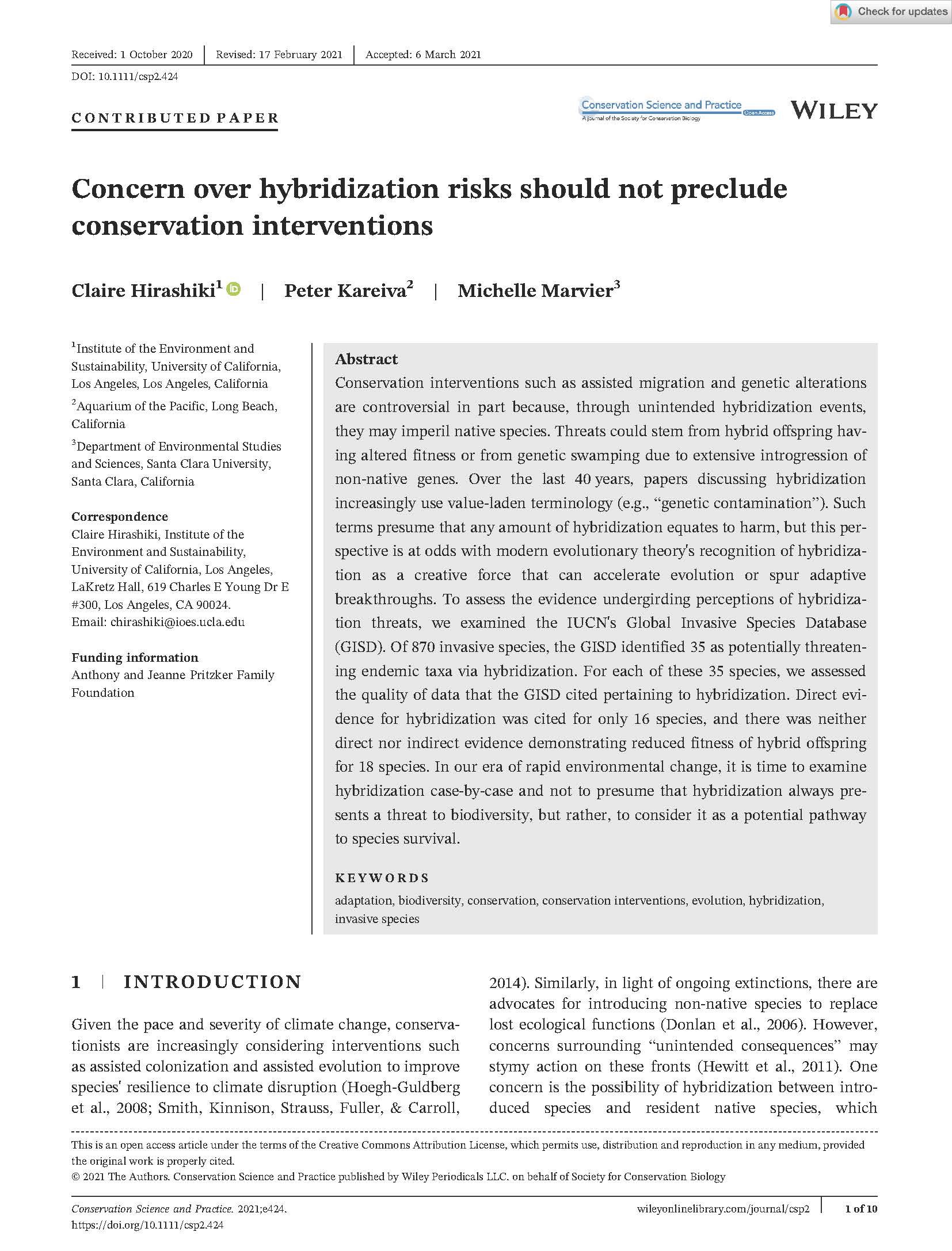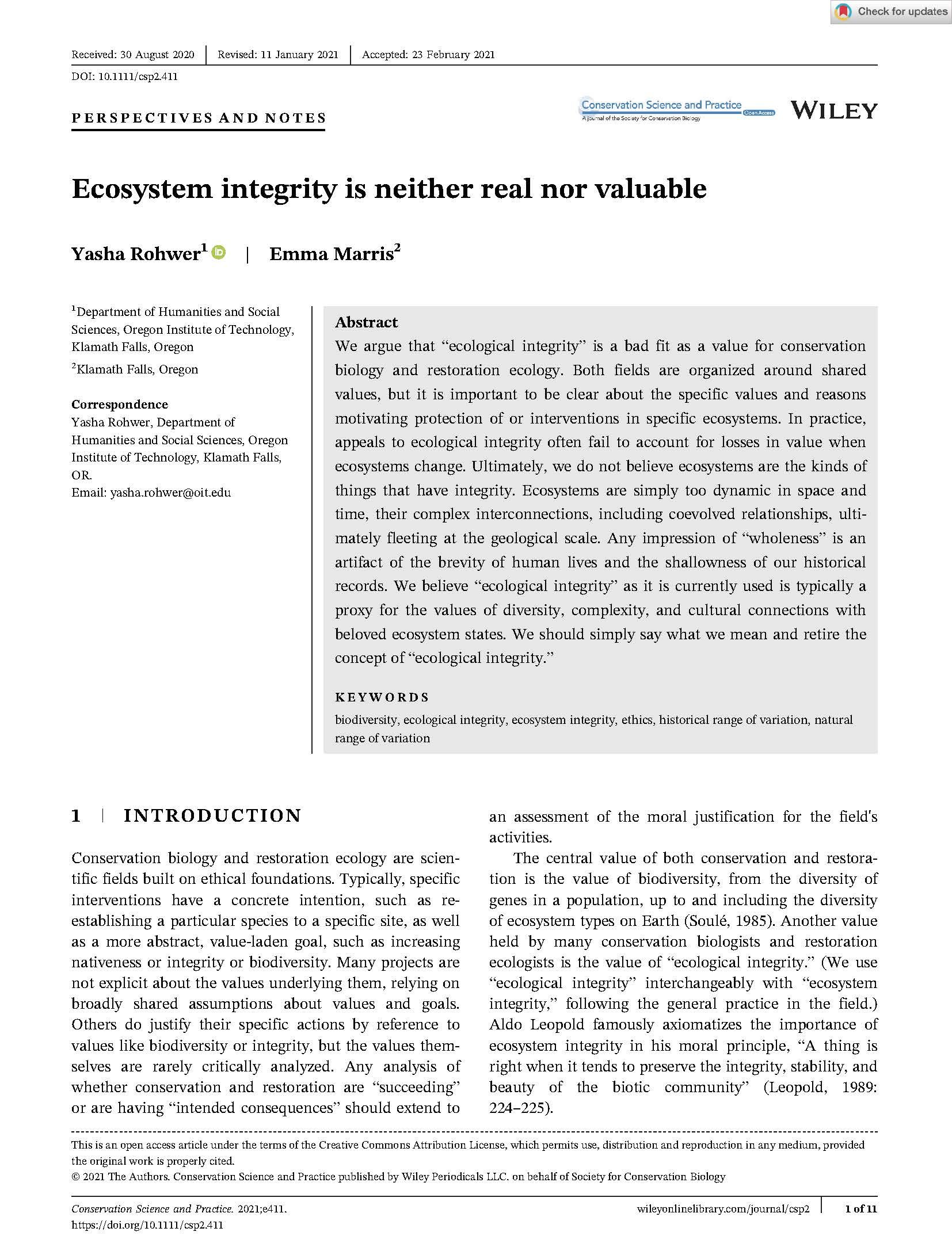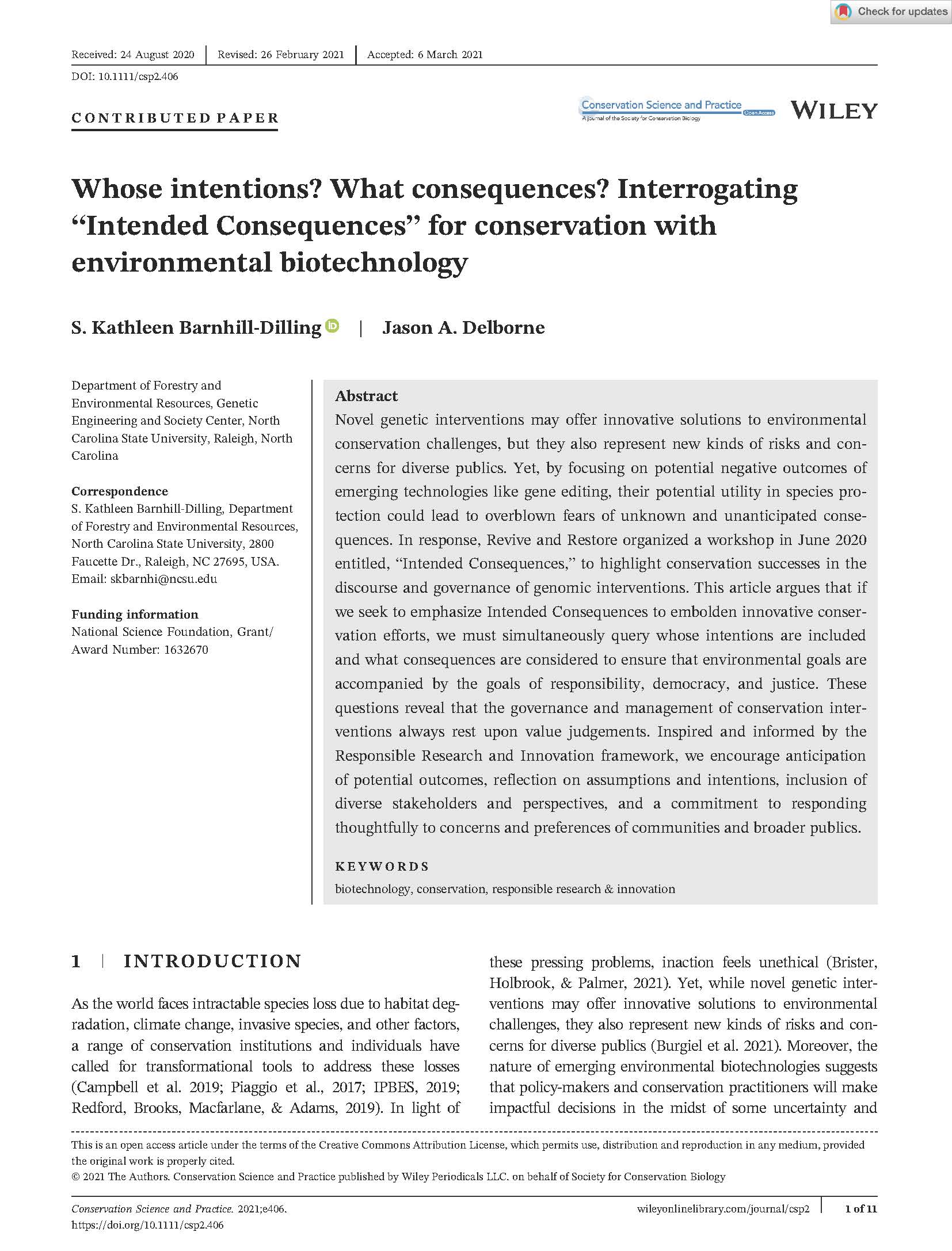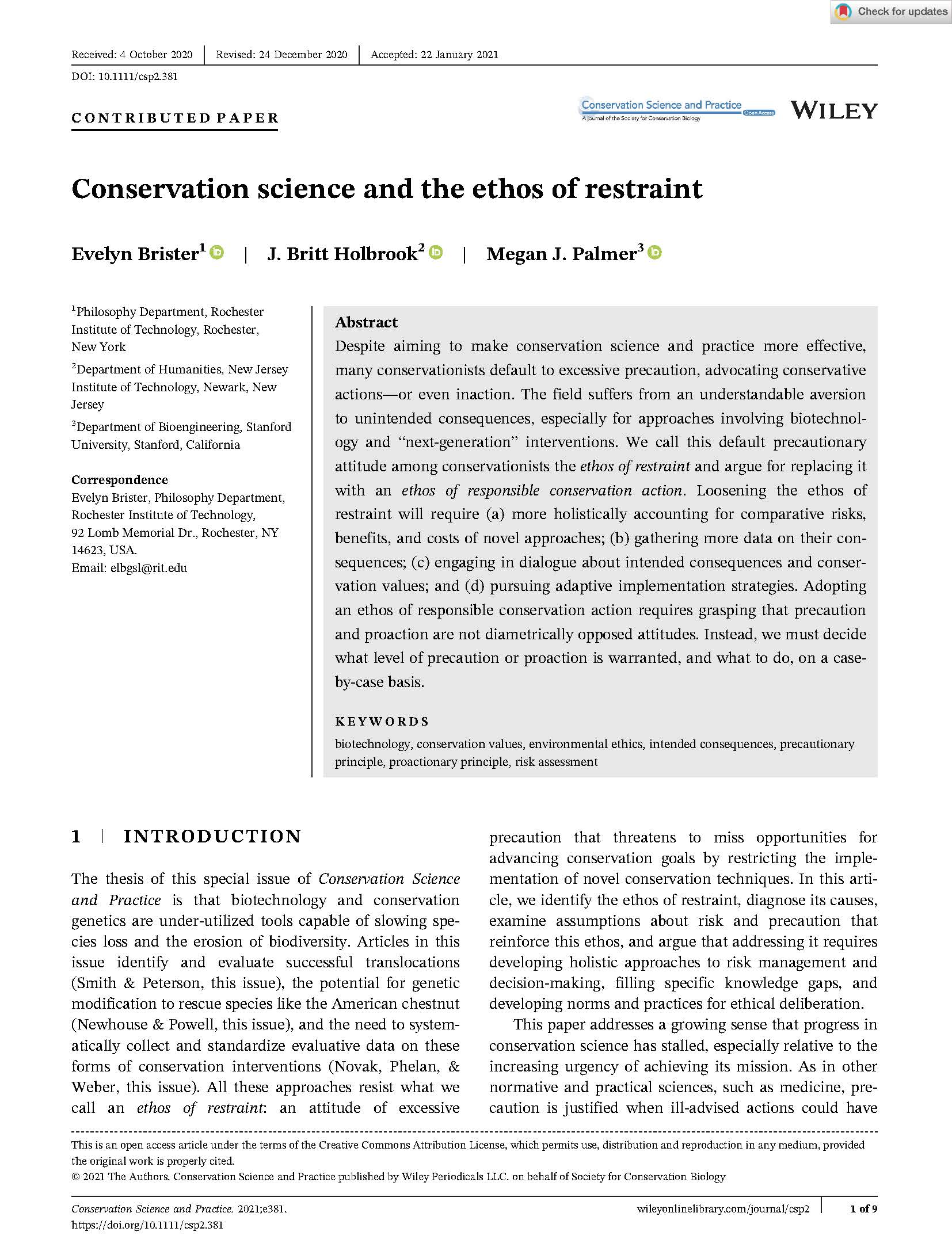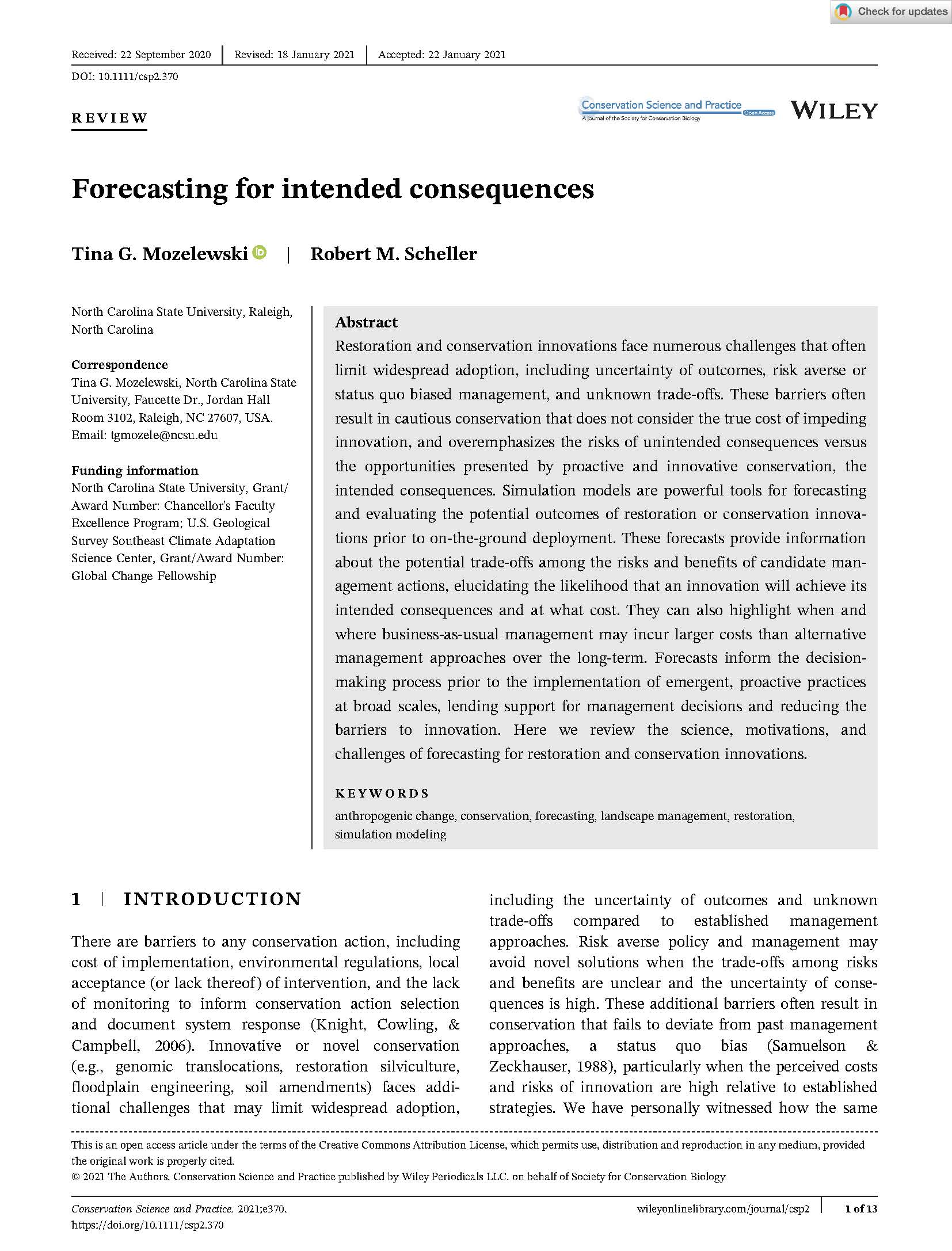The Issue At-A-Glance
The authors of this special issue collaborated to design a comprehensive set of articles delving into the multifaceted issue of Intended Consequences from a broad range of perspectives.
The editorial Why Intended Consequences? defines the initiative and urges a rebalancing of the risk-benefit equation when considering conservation interventions to include the cost of inaction as well as the potential benefits. The Intended Consequences Statement, authored by 46 of the Intended Consequences workshop participants, provides guidance for safely harnessing the power of innovation for conservation. A review of U.S. Conservation Translocations reveals the high success rate of conservation translocations and biological control releases, which have reliably yielded biodiversity gains over the past 140 years. Two papers detail a spectrum of genetic intervention: From a Reintroduction of Wolves to US national parks to the development of a blight-tolerant Transgenic American Chestnut Tree. Two papers question historical conventions in conservation, namely that of Ecosystem Integrity and the “threat” of Hybridization to genetic purity. Another diagnoses the causes and consequences of the Ethos of Restraint, which delays conservation action. Finally, three articles examine opportunities to improve planning for intended consequences: a framework for Responsible Research for the use of environmental biotechnology; a perspective on the intersections of Governance, Constituencies, and Risk; and the ability to visualize uncertainties and trade-offs for new innovations using Forecasting Models.
Browse the abstracts below or view the full special issue at Conservation Science and Practice. It is open access, freely available to all.
About the cover: Together for 9 years, these wolves have the longest pair bond known for their species. They are descendants of a Yellowstone National Park wolf reintroduction program that initially drew controversy but is now widely considered a success. The reintroduction is detailed by Doug Smith and Rolf Peterson. (Click photo to enlarge. Courtesy Ronan Donovan)
ABSTRACTS
Ryan Phelan, Peter Kareiva, Michelle Marvier, Paul Robbins, Michele Weber
Novel conservation interventions such as assisted migration or gene editing inevitably raise the specter of potential unintended consequences, which can then delay or derail action. Underappreciated are the very real costs of inaction. The rate of climate change and the pace of extinction continue to outstrip predictions (IPCC, 2019). The current pace of unprecedented environmental change calls for more attention being given to the consequences of failing to intervene. While it is important to plan for potential unintended risks of any intervention, it is just as important to mitigate the risks of carrying on with business as usual in the face of increasingly severe environmental threats.
As the biodiversity crisis accelerates, the stakes are higher for threatened plants and animals. Rebuilding the health of our planet will require addressing underlying threats at many scales, including habitat loss and climate change. Conservation interventions such as habitat protection, management, restoration, predator control, translocation, genetic rescue, and biological control have the potential to help threatened or endangered species avert extinction. These existing, well-tested methods can be complemented and augmented by more frequent and faster adoption of new technologies, such as powerful new genetic tools. In addition, synthetic biology might offer solutions to currently intractable conservation problems. We believe that conservation needs to be bold and clear-eyed in this moment of great urgency.
Abstract: Conservation translocations (reintroductions, reinforcements, ecological replacements, and assisted colonization) have played a vital and necessary role in conserving endangered species and ecosystems. Yet concerns over potential unintended ecological consequences frequently hinder the progress of translocation activities. We reviewed the history of U.S. translocations to ask: how often were intended benefits the result versus harmful unintended consequences? We found that translocations played a key role in recovery for 30% (14 of 47) of U.S. delisted taxa. Translocations have been performed, are planned, or are part of continuing recovery actions for 70% (1,112 of 1,580) of listed threatened and endangered taxa. Of 1,013 total taxa we found with recorded conservation translocations spanning 125 years we found only one restricted instance that caused a loss of biodiversity. All other reports of negative consequences were caused by translocations performed for economic and cultural interests in the absence of conservation-based governance. Examples included fish stocking for sport and biological control programs for agricultural pests. We included biological control programs in this analysis because they can be and often are used as conservation tools, to directly benefit ecosystems. In addition, they are often raised as examples of harmful unintended results during the conservation planning process. However, only 1.4% (42) of 3,014 biological control agents released globally have caused ecosystem-level deleterious impacts. All of these were initially released before the 1980s and conservation-based practice and governance in recent decades have reduced off-target impacts from biological control practice. Two themes emerged from our review: 1) conservation translocations routinely yielded their intended benefits without producing unintended harm, and 2) when ecological damage did occur, it was in the absence of conservation practice and regulation. This evidence shows that well-planned translocation efforts produce ecosystem benefits, which should be weighed against the costs of inaction when deliberating conservation strategies.
Abstract: Wolves (Canis lupus), a once widely distributed species, were systematically removed from many temperate zone ecosystems due to conflicts with humans. A change in human attitudes and cultural norms has brought about a recovery in some suitable areas, yet reintroductions are still controversial. Two notable reintroduction areas were Yellowstone and Isle Royale national parks. Both proposals caused polarization and debate. In Yellowstone opposition focused on outside the park affects mainly wolves killing livestock and wild game also desired by human hunters. At Isle Royale opposition was mostly about human interventions into nature and impairment of wilderness values contrary to the spirit of the 1964 Wilderness Act. Both locations had time periods in the 20th century with and without wolves and the presence of wolves had a dampening effect on ungulate population fluctuations. Most outcomes of reintroduction at Yellowstone were predicted as the Environmental Impact Statement (EIS) written beforehand correctly predicted 78% of the 51 outcomes that were examined. Wolves were too recently reintroduced to Isle Royale to make similar comparisons, but we conclude that intervention is not contrary to the Wilderness Act, nor Howard Zahniser’s vision who authored it, and that Isle Royale was already impacted by humans, so not intervening would have had more damaging to impacts to ecosystem functioning.
Abstract: In contrast to many current applications of biotechnology, the intended consequence of the American Chestnut Research & Restoration Project is to produce trees that are well-adapted to thrive not just in confined fields or orchards, but throughout their natural range. Our primary focus is on disease tolerance, but we believe it will also be critically important that optimal restoration trees should have robust genetic diversity and resilience, which can be supplied by a full complement of their wild-type genes. Chestnut restoration offers a unique case study because many restoration or intervention options have been attempted: doing nothing, planting non-native chestnut species, planting hybrids, mutagenesis (exposing seeds to high levels of radiation to induce random mutations), backcross breeding, and now genetic engineering. Any of these techniques may be advantageous independently or in combinations, depending on the specific goals of land managers or restoration practitioners, but genetic engineering offers a unique opportunity to enhance blight tolerance while minimizing other changes to the genome.
Abstract: Conservation interventions such as assisted migration and genetic alterations are controversial in part because, through unintended hybridization events, they may imperil native species. Threats could stem from hybrid offspring having altered fitness or from genetic swamping due to extensive introgression of non-native genes. Over the last forty years, papers discussing hybridization increasingly use value-laden terminology (e.g., “genetic contamination”). Such terms presume that any amount of hybridization equates to harm, but this perspective is at odds with modern evolutionary theory’s recognition of hybridization as a creative force that can accelerate evolution or spur adaptive breakthroughs. To assess the evidence undergirding perceptions of hybridization threats, we examined the IUCN’s Global Invasive Species Database (GISD). Of 870 invasive species, the GISD identified 35 as potentially threatening endemic taxa via hybridization. For each of these 35 species, we assessed the quality of data that the GISD cited pertaining to hybridization. Direct evidence for hybridization was cited for only 16 species, and there was neither direct nor indirect evidence demonstrating altered fitness of hybrid offspring for 18 species. In a time of rapid environmental change, biodiversity would be better served if conservationists abandon presumptions that hybridization always constitutes a threat and instead rely upon data.
Abstract: We argue that “ecological integrity” is a bad fit as a value for conservation biology and restoration ecology. Both fields are organized around shared values, but it is important to be clear about the specific values and reasons motivating interventions in or protection of specific ecosystems. In practice, appeals to ecological integrity often fail to account for losses in value when ecosystems change. Ultimately, we don’t believe ecosystems are the kinds of things that have integrity. Ecosystems are simply too dynamic in space and time, their complex interconnections, including coevolved relationships, ultimately fleeting at the geological scale. Any impression of “wholeness” is an artifact of the brevity of human lives and the shallowness of our historical records. We believe “ecological integrity” as it is currently used is typically a proxy for the values of diversity, complexity, and cultural connections with beloved ecosystem states. We should simply say what we mean and retire the concept of “ecological integrity.”
Abstract: Novel genetic interventions may offer innovative solutions to environmental conservation challenges, but they also represent new kinds of risks and concerns for diverse publics. Yet, by focusing on potential negative outcomes of emerging technologies like gene editing, their potential utility in species protection could lead to overblown fears of unknown and unanticipated consequences. In response, Revive and Restore organized a workshop in June 2020 entitled, “Intended Consequences,” to highlight conservation successes in the discourse and governance of genomic interventions. This paper argues that if we seek to emphasize Intended Consequences to embolden innovative conservation efforts, we must simultaneously query whose intentions are included and what consequences are considered to ensure that environmental goals are accompanied by the goals of responsibility, democracy, and justice. These questions reveal that the governance and management of conservation interventions always rest upon value judgements. Inspired and informed by the Responsible Research and Innovation framework, we encourage anticipation of potential outcomes, reflection on assumptions and intentions, inclusion of diverse stakeholders and perspectives, and a commitment to responding thoughtfully to concerns and preferences of communities and broader publics.
Abstract: Despite aiming to make conservation science and practice more effective, many conservationists default to excessive precaution, advocating conservative actions – or even inaction. The field suffers from an understandable aversion to unintended consequences, especially for approaches involving biotechnology and “next-generation” interventions. We call this default precautionary attitude among conservationists the ethos of restraint and argue for replacing it with an ethos of responsible conservation action. Loosening the ethos of restraint will require (1) more holistically accounting for comparative risks, benefits, and costs of novel approaches; (2) gathering more data on their consequences; (3) engaging in dialogue about intended consequences and conservation values; and (4) pursuing adaptive implementation strategies. Adopting an ethos of responsible conservation action requires grasping that precaution and proaction are not diametrically opposed attitudes. Instead, we must decide what level of precaution or proaction is warranted, and what to do, on a case-by-case basis.
Abstract: Restoration and conservation innovations face numerous challenges that often limit widespread adoption, including uncertainty of outcomes, risk averse or status quo biased management, and unknown trade-offs. These barriers often result in cautious conservation that does not consider the true cost of impeding innovation, and overemphasizes the risks of unintended consequences versus the opportunities presented by proactive and innovative conservation, the intended consequences. Simulation models are powerful tools for forecasting and evaluating the potential outcomes of restoration or conservation innovations prior to on-the-ground deployment. These forecasts provide information about the potential trade-offs among the risks and benefits of candidate management actions, elucidating the likelihood that an innovation will achieve its intended consequences and at what cost. They can also highlight when and where business-as-usual management may incur larger costs than alternative management approaches over the long-term. Forecasts inform the decision- making process prior to the implementation of emergent, proactive practices at broad scales, lending support for management decisions and reducing the barriers to innovation. Here we review the science, motivations, and challenges of forecasting for restoration and conservation innovations.
Abstract: In June 2020, Revive & Restore hosted the Intended Consequences Workshop to explore how the field of conservation can realize the benefits of genetic interventions and address concerns about unintended consequences of these actions. A group of 57 participants from eight countries representing government, academia, and conservation practice discussed how implementation of genetic interventions designed to achieve conservation objectives can be optimized to both address concerns about risk and achieve the intended consequences. Genetic interventions are efforts designed to manipulate the genetic composition of a conservation target at a species or population level. The planning and implementation of genetic interventions in conservation raises questions about how key constituencies are involved in the process and how risks and benefits are characterized and evaluated. Governance frameworks are critical to structuring dialogue and decision-making among interested parties around the development of these conservation efforts in a manner that addresses risks, benefits, and equity considerations. In this article, we explore related issues of policy and governance, key constituencies, and risk as raised during discussions at a 2020 workshop on “Intended Consequences” of conservation interventions. We examine how different constituencies characterize risks of genetic interventions within particular sociocultural contexts. We then revisit the characterization and framing of risks to suggest ways that the perspectives of different constituencies can be visualized in a manner to inform resulting policy decisions.
SPECIAL ISSUE SPONSORS
